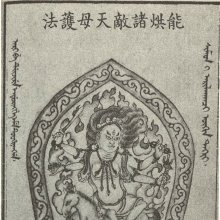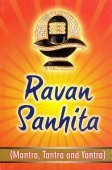Dhumavati, Dhuma-vati, Dhūmāvatī: 10 definitions
Introduction:
Dhumavati means something in Hinduism, Sanskrit. If you want to know the exact meaning, history, etymology or English translation of this term then check out the descriptions on this page. Add your comment or reference to a book if you want to contribute to this summary article.
Images (photo gallery)
In Hinduism
Shaktism (Shakta philosophy)
Source: Wisdom Library: ŚāktismDhūmāvatī (धूमावती, “the smokey one”):—The seventh of the ten Mahāvidyās. She represents the power of poverty. She is the Śakti (‘power’) that destroys the structure of all things. She is the presiding deity of the rainy season. Her power represents poverty and misfortune, such as seen with the beggars, the lepers and the diseased. Her power resides within abandoned places of despair, such as ruined houses, deserts and battle-fields.
The ten Mahāvidyās are the emanations of Mahākālī, the Goddess of time and death. She is depicted as a fearful laughing goddess with four arms entwined with poisonous snakes in her hair. She has three red eyes, a wagging tongue and feaful teeth. Her left foot is standing on a corpse
Source: Red Zambala: The 10 Great Wisdom GoddessesAfter death the body is consigned to the funeral pyre, our entire subjective, assumptive universe ends in smoke; hence the power of ultimate destruction is called Dhūmāvatī (“the Smoky-One”). She is the śakti that destroys the structure of all things, (structure is ruled over by the male principle whereas process is the feminine energy), hence she is called a widow (vidhava). Nothing is left for her to own, hence she is utterly destitute. She is Daridra (“the goddess-of- poverty”), of frustration, of despair, identified with Alakṣmī (“Misfortune”) and with Nirṛti (“the goddess-of-disease and misery”).
Dhūmāvatī rules over the rainy season which lasts for four months, during which the life-giving solar light is hidden by the evil water-spirit (asura-apya-prāṇa). This corresponds in the cosmic cycle to the night of the gods when the spirits of darkness rule.

Shakta (शाक्त, śākta) or Shaktism (śāktism) represents a tradition of Hinduism where the Goddess (Devi) is revered and worshipped. Shakta literature includes a range of scriptures, including various Agamas and Tantras, although its roots may be traced back to the Vedas.
Purana and Itihasa (epic history)
Source: archive.org: Puranic EncyclopediaDhūmāvatī (धूमावती).—A holy place. The wishes of those who take three days' fast in this holy place are realised. (Mahābhārata Vana Parva, Chapter 84, Stanza 22).
Source: JatLand: List of Mahabharata people and placesDhūmāvatī (धूमावती) refers to the name of a Tīrtha (pilgrim’s destination) mentioned in the Mahābhārata (cf. III.82.20). Note: The Mahābhārata (mentioning Dhūmā-vatī) is a Sanskrit epic poem consisting of 100,000 ślokas (metrical verses) and is over 2000 years old.

The Purana (पुराण, purāṇas) refers to Sanskrit literature preserving ancient India’s vast cultural history, including historical legends, religious ceremonies, various arts and sciences. The eighteen mahapuranas total over 400,000 shlokas (metrical couplets) and date to at least several centuries BCE.
General definition (in Hinduism)
Source: WikiPedia: HinduismDhumavati is one of the Mahavidyas, a group of ten Tantric goddesses. She represents the fearsome aspect of Devi, the Hindu Divine Mother. She is often portrayed as an old, ugly widow, and is associated with things considered inauspicious and unattractive in Hinduism, such as the crow and the Chaturmas period. The goddess is often depicted on a horseless chariot or riding a crow, usually in a cremation ground.
etymology: Dhumavati (Sanskrit: धूमावती, Dhūmāvatī, literally "the smoky one")
Source: Manblunder Plus: DhūmāvatīDhūmāvatī is the seventh of ten Mahāvidyās. Dhūma means smoke and Dhūmāvatī is said to be in the form of smoke, mostly relating to funeral pyre. Out of the ten Mahāvidyās, only Dhūmāvatī is considered as inauspicious. She looks very aged, wearing rags, unkempt hair, wrinkles on her face and all over the body.
She has strange liking for bones and blood. She is depicted with carrying a broom stick, garland made of skulls, chewing corpses, etc. It is said that she was born in the place where Pārvatī, Consort of Shiva, immolated herself in homa fire of her father Dakṣa, by entering into the sacrificial fire. From the fire, thick smoke came and this is said to be Dhūmāvatī. There is another story wherein Shiva cursed her to become a widow.
Languages of India and abroad
Sanskrit dictionary
Source: DDSA: The practical Sanskrit-English dictionaryDhūmāvatī (धूमावती).—f. One of the ten great goddesses of learning; विद्या धूमावती तथा (vidyā dhūmāvatī tathā) Tantrasāra.
Source: Cologne Digital Sanskrit Dictionaries: Monier-Williams Sanskrit-English DictionaryDhūmāvatī (धूमावती):—[=dhūmā-vatī] [from dhūma > dhū] f. Name of a place of pilgrimage, [Mahābhārata]
[Sanskrit to German]
Sanskrit, also spelled संस्कृतम् (saṃskṛtam), is an ancient language of India commonly seen as the grandmother of the Indo-European language family (even English!). Closely allied with Prakrit and Pali, Sanskrit is more exhaustive in both grammar and terms and has the most extensive collection of literature in the world, greatly surpassing its sister-languages Greek and Latin.
See also (Relevant definitions)
Starts with: Dhumavati-stava, Dhumavatidipadanapuja, Dhumavatimantra, Dhumavatimanu, Dhumavatipatala, Dhumavatipujapaddhati.
Query error!
Full-text: Dhumavatipatala, Dhumavatimanu, Dhumavatimantra, Mahavidya, Dhumavatipujapaddhati, Dhumavatidipadanapuja, Dhumavati-stava, Mahavidhya, Kamala, Kalaratri, Uttaramnaya, Mahakali, Varahi.
Relevant text
Search found 15 books and stories containing Dhumavati, Dhuma-vati, Dhūmā-vatī, Dhūmāvatī; (plurals include: Dhumavatis, vatis, vatīs, Dhūmāvatīs). You can also click to the full overview containing English textual excerpts. Below are direct links for the most relevant articles:
Diaspora of Bhuta (Daiva) worshipping cult—India and Indonesia (by Shilpa V. Sonawane)
Part 1.10 - Dhumavati—Das Mahavidya and form of Adi Parashakti < [Chapter 4 - Inter-Disciplinary Analysis]
Chapter 5 - Conclusion and Observations
Part 7-8 - Jumadi (or Dhumavati) < [Chapter 1 - Introduction]
Shiva Purana (by J. L. Shastri)
Chapter 17 - Ten incarnations of Śiva < [Section 3 - Śatarudra-saṃhitā]
Chapter 47 - Dhūmralocana, Caṇḍa, Muṇḍa and Raktabīja are slain < [Section 5 - Umā-Saṃhitā]
Devi Tantra, Mantra, Yantra (study) (by Srider Basudevan Iyer)
Description of the Dasa Mahavidya Devatas (Ten great Knowledges) < [Chapter 3 - Minor Goddesses]
Vedic Goddesses (1): Aditi < [Chapter 2 - The Maior Goddesses]
Soundarya Lahari of Shri Shankara (Study) (by Seetha N.)
The various deities of Saktism < [Chapter 5 - Shakta-Tantras—Saundaryalahari as an epitome of Shaktism]
Notices of Sanskrit Manuscripts (by Rajendralala Mitra)
Temples of Purushottama Kshetra Puri (by Ratnakar Mohapatra)
7. Bata-Mangala Temple (in Puri) < [Chapter 6 - Shakta Temples of Purushottama Kshetra]
5. Sarva-Mangala Temple (in Puri) < [Chapter 6 - Shakta Temples of Purushottama Kshetra]
5. Nilakanthesvara Temple at Matiapara < [Chapter 5 - Shaiva Temples of Purushottama Kshetra]
Related products

